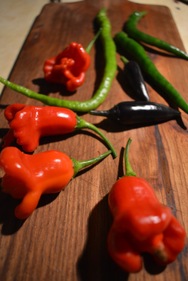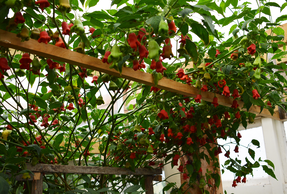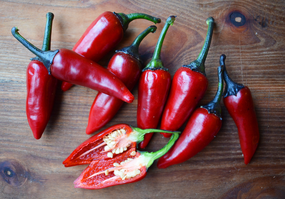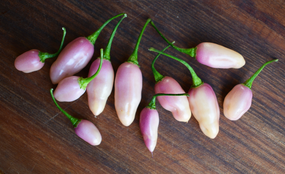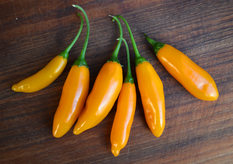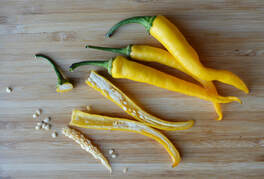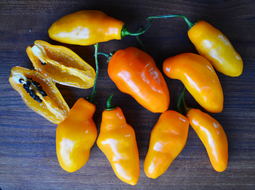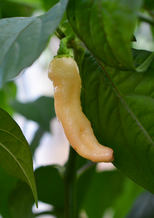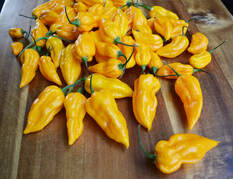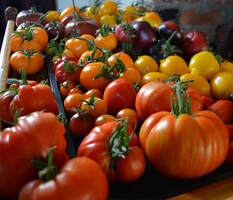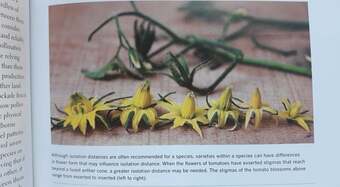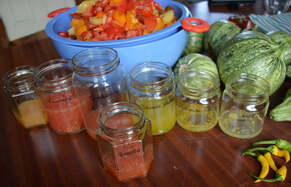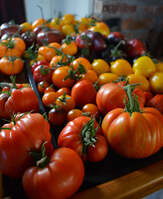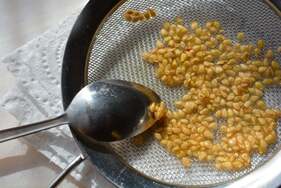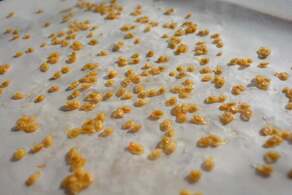Solanaceae Family
|
SEED SAVING
|
PEPPERS - Capsicum spp.
|
Capsicum spp. - Peppers
Family - Solanaceae Genus - Capsicum Species - Baccatum, Annum, Chinense, Frutescens and Pubescens. Plant type - Annual and Perennial Flower type - Perfect and self fertile Pollination - Self pollination (autogamous) and insect pollinated Recommended isolation distance - 500m Expected seed viability - 2-4 years Genetic diversity -
|
Jasmin Hill
24 May 2022
Chillies Chillies Chillies!! 🌶🌶🌶
I have never seen so many chillies before in my whole life! Kilos and kilos of them, I'm blown away by my chillies!
Chillies have perfect flowers, this means that they have both female and male parts in the same flower so they self pollinate, most flowers will pollinate themselves with a little disturbance. Sometimes this disturbance is from insects so they can cross pollinate if that insect has been sitting in another chilli flower from the same species.
There are 5 different species of chillies
I have three different glasshouses so I have been able to isolate many of these varieties by only having one of their species in each glasshouse however when I grow more than one of the same species in the same glasshouse then I plant them away from each. I have seen differing opinions on the likelyhood of chillies cross pollinating in this situation, other more experienced chilli seed savers I have spoken to have noted it to be very rare.
I would be really interested to know if anyone gets any crossed seeds from me!
24 May 2022
Chillies Chillies Chillies!! 🌶🌶🌶
I have never seen so many chillies before in my whole life! Kilos and kilos of them, I'm blown away by my chillies!
Chillies have perfect flowers, this means that they have both female and male parts in the same flower so they self pollinate, most flowers will pollinate themselves with a little disturbance. Sometimes this disturbance is from insects so they can cross pollinate if that insect has been sitting in another chilli flower from the same species.
There are 5 different species of chillies
- C. annuum - your most common species of chilli, varieties including your sweet bell peppers, jalapeños, Jimmy nardello, paprika, cayenne.. etc
- C. baccatum - My favourite chilli to grow, originating from Peru and grown at altitudes so they can handle the cold here. Varieties including, Sugar Rush peach, bishops crown, most of the Aji's.. Aji pineapple, Aji limon, Aji amarillo.. etc. They are usually a nice medium heat 30,000-50,000 SHU similar to cayenne but less burny
- C. Chinense - Your hottest chillies and from tropical origins so they need more warmth especially to set good seeds, varieties include your super hots, habaneros, Reapers, Bhut jolokia, Fatalii, Scotch bonnet.. etc.
- C. frutescens - From Central or South America they are usually quite small and grow upright, typically short and bushy plants that are great for growing in pots. Varieties include Tobasco, Piri Piri.. I grow a variety that is a cross between C. frutescens and C. annum called Bangalore whippets tail, it's FABULOUS!
- C. pubescens - Often grown at altitudes, from Peru, Bolivia Ecuador and they can really handle the cold, easily identified by their black seeds. Only variety I know if is Rocoto, I have two Orange Rocoto plants growing and plenty of seeds for them. They pack a punch at about 100,000 SHU.. Nice big chillies with thick wall.
I have three different glasshouses so I have been able to isolate many of these varieties by only having one of their species in each glasshouse however when I grow more than one of the same species in the same glasshouse then I plant them away from each. I have seen differing opinions on the likelyhood of chillies cross pollinating in this situation, other more experienced chilli seed savers I have spoken to have noted it to be very rare.
I would be really interested to know if anyone gets any crossed seeds from me!
|
Solanum lycopersicum - Tomato
Family - Solanaceae Genus - Solanum Species - lycopersicum Plant type - Annual Flower type - Perfect and self fertile Pollination - Self pollination (possible but rare insect pollination) Recommended isolation distance - 3-15m Expected seed viability - 4-6 years (or longer) Genetic diversity -
|
Jasmin Hill
10 August 2022
Lets talk Tomato Seed Saving
Tomatoes are absolutely one of my favourite plants to grow and I also really enjoy saving their seeds!
Tomato seeds are a great place to start for beginner seed savers, they are fun to grow with plenty of great variety, they rarely cross pollinate and the seeds are ripe and ready at the same time as the fruit are ready to eat.
My number one rule for saving any seeds it to be sure you are saving them from a strong and healthy plant. This will encourage future strong genetics and also avoid passing on seed borne virus's and disease.
Cross pollination - Tomato flowers are Perfect (meaning that they have both male and female parts) so they are self pollinating. There is some variation in the flowers amongst the different varieties of tomatoes where the stigmas may be exerted, which can lead to insect cross pollination, this is more common in potato leaf varieties.
Exerted stigmas (Pictured below) are also common in the double blossomed flowers that commonly occur in the first set of fruit especially from beefsteak varieties, this is why it is not recommended to save seeds from these fruit unless isolation techniques have been used. Generally though it is quite rare that tomatoes cross pollinate so home gardeners can usually feel quite comfortable saving seeds from many different varieties growing together.. If your plants are really close and you have a lot of insects around that could cause cross pollination easily then take a close look at your tomato flowers. If they have exerted stigmas then maybe consider bagging individual flowers, or bunches of flowers for seed saving purposes. Again it it very rare for tomatoes to cross.. but it is possible.
Genetic Diversity - There are some recommendations in my books about numbers of plants to grow for GD..
Viable Seeds - 1 Plant
Variety Maintenance - 5 - 10 plants
Genetic Preservation - 20 Plants
In breeding depression is not usually a problem with tomatoes so these are just guidelines to take into account for capturing a varieties full GD.
Selecting desirable fruit and nice strong plants for Seed Saving is important. Consider each varieties important traits such as fruit size, shape, colour and patterns, Also consider the plants overall growth habits, and leaf formation.
Cleaning and Storing - The most ideal way of saving your Tomato seeds is through the fermentation process. Saving your tomato seeds this way will remove the gel coating from around each seed which harbours pathogens and may contain germination inhibitors. Fermenting your seeds is also a great way to remove non-viable seeds, and allow you to store your seeds clean and dry to insure you have nice viable seeds for many years to come!
Ferment -
Scoop the seeds out of your tomato into a jar and add about an equal amount of water to help begin fermentation. Label your jar and leave it in a warm spot for aprox 3 days to ferment, this time will vary greatly depending on the temperature. Smell your seeds and you will notice a distinct change in the smell when they begin fermenting. Give them a good stir to encourage the little gel coatings to fall away from the seed and help break away any excess pulp.
Rinse -
When you are confident your tomato seeds are ready, fill the jar with water and stir well, let the seeds settle to the bottom and tip off any excess floating pulp. Non viable seeds will most likely float so tip the floaters away. Repeat until your seeds look nice and clean.
Dry -
Fill the jar with water and tip your seeds into a sieve, this will avoid them sticking to the jar. Fold a paper towel and place under the sieve to absorb any excess water then lay out on baking paper in a warm spot to dry (out of direct sunlight). As your seeds dry they will become beautiful and fluffy! Leave them for a few days before storing. As your seeds dry they will become beautiful and fluffy. Leave them for a few days before storing.
This is my process for fermenting tomato seeds, there are variations of course :)
10 August 2022
Lets talk Tomato Seed Saving
Tomatoes are absolutely one of my favourite plants to grow and I also really enjoy saving their seeds!
Tomato seeds are a great place to start for beginner seed savers, they are fun to grow with plenty of great variety, they rarely cross pollinate and the seeds are ripe and ready at the same time as the fruit are ready to eat.
My number one rule for saving any seeds it to be sure you are saving them from a strong and healthy plant. This will encourage future strong genetics and also avoid passing on seed borne virus's and disease.
Cross pollination - Tomato flowers are Perfect (meaning that they have both male and female parts) so they are self pollinating. There is some variation in the flowers amongst the different varieties of tomatoes where the stigmas may be exerted, which can lead to insect cross pollination, this is more common in potato leaf varieties.
Exerted stigmas (Pictured below) are also common in the double blossomed flowers that commonly occur in the first set of fruit especially from beefsteak varieties, this is why it is not recommended to save seeds from these fruit unless isolation techniques have been used. Generally though it is quite rare that tomatoes cross pollinate so home gardeners can usually feel quite comfortable saving seeds from many different varieties growing together.. If your plants are really close and you have a lot of insects around that could cause cross pollination easily then take a close look at your tomato flowers. If they have exerted stigmas then maybe consider bagging individual flowers, or bunches of flowers for seed saving purposes. Again it it very rare for tomatoes to cross.. but it is possible.
Genetic Diversity - There are some recommendations in my books about numbers of plants to grow for GD..
Viable Seeds - 1 Plant
Variety Maintenance - 5 - 10 plants
Genetic Preservation - 20 Plants
In breeding depression is not usually a problem with tomatoes so these are just guidelines to take into account for capturing a varieties full GD.
Selecting desirable fruit and nice strong plants for Seed Saving is important. Consider each varieties important traits such as fruit size, shape, colour and patterns, Also consider the plants overall growth habits, and leaf formation.
Cleaning and Storing - The most ideal way of saving your Tomato seeds is through the fermentation process. Saving your tomato seeds this way will remove the gel coating from around each seed which harbours pathogens and may contain germination inhibitors. Fermenting your seeds is also a great way to remove non-viable seeds, and allow you to store your seeds clean and dry to insure you have nice viable seeds for many years to come!
Ferment -
Scoop the seeds out of your tomato into a jar and add about an equal amount of water to help begin fermentation. Label your jar and leave it in a warm spot for aprox 3 days to ferment, this time will vary greatly depending on the temperature. Smell your seeds and you will notice a distinct change in the smell when they begin fermenting. Give them a good stir to encourage the little gel coatings to fall away from the seed and help break away any excess pulp.
Rinse -
When you are confident your tomato seeds are ready, fill the jar with water and stir well, let the seeds settle to the bottom and tip off any excess floating pulp. Non viable seeds will most likely float so tip the floaters away. Repeat until your seeds look nice and clean.
Dry -
Fill the jar with water and tip your seeds into a sieve, this will avoid them sticking to the jar. Fold a paper towel and place under the sieve to absorb any excess water then lay out on baking paper in a warm spot to dry (out of direct sunlight). As your seeds dry they will become beautiful and fluffy! Leave them for a few days before storing. As your seeds dry they will become beautiful and fluffy. Leave them for a few days before storing.
This is my process for fermenting tomato seeds, there are variations of course :)
Solanum melongena - Eggplant
Family - Solanaceae
Genus - Solanum
Species - melongena
Plant type - Annual
Flower type - Perfect and self fertile
Pollination - Self pollination and insect pollination
Recommended isolation distance - 500m
Expected seed viability - 4-6 years
Genetic diversity -
Family - Solanaceae
Genus - Solanum
Species - melongena
Plant type - Annual
Flower type - Perfect and self fertile
Pollination - Self pollination and insect pollination
Recommended isolation distance - 500m
Expected seed viability - 4-6 years
Genetic diversity -
- Viable seed - 1 plant
- Variety maintenance - 5-20 plants
- Genetic preservation - 50 plants
Solanum tuberous - Potato
Family - Solanaceae
Genus - Solanum
Species - tuberous
Plant type - Annual
Family - Solanaceae
Genus - Solanum
Species - tuberous
Plant type - Annual
